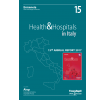Health & Hospitals in Italy. 15th Annual Report 2017
Synopsis
Pubblicato con licenza Creative Commons Attribuzione-Non Commerciale-Non opere derivate 3.0 Italia (CC-BY-NC-ND 3.0 IT) nella collana Aiop - Associazione italiana ospedalità privata - Open Access
Again this year the 2017 Health & Hospitals Report gives an account of the performance of the Italian hospital system, which is quite a substantial organization: 1,100 healthcare institutes, 200,000 patient beds, 8.9 million hospitalizations, more than 630,000 workers and a total expenditure of EUR 62.3 billion, equivalent to 55.3% of total public health spending.
Thus it is an extremely complex "machine", on the one hand, and an equally complex world of users receiving the various services, on the other. For these reasons the Report takes both components into consideration.
Firstly, this year users and caregivers were assessed as they endeavor to deal with all of the continually increasing weaknesses inherent to public services and to implement reaction strategies to offset them. These include seeking out alternatives in accredited (and non-accredited) private facilities, making use of hospitals outside the home Region, improper use of the Emergency Room for hospitalization, and out-of-pocket spending by families. The individual types of these out-of-pocket expenses (whether for healthcare or assistance) have been identified, along with the reasons that have driven the families
to invest their own resources. Parallel to this, the financial statements of the Hospital Centers have been analyzed, identifying some "anomalies" that might hide improper methods of covering budgets: this certainly does not point in the direction of transparent and comparable reporting - as provided for by current legislation - that helps to better manage (limited) public resources to provide better service to users.
Italy needs to defend the universal and inclusive principle upon which the National Health System is based in a concrete manner, but precisely for this reason it is absolutely necessary to make the most appropriate use of the financial resources available to better balance the needs of patients, on the one hand, and the efficiency/effectiveness of facilities and services, on the other.
Downloads


